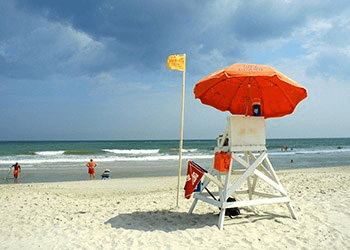Texas Beaches Can Be Fun, But Know The Rules Of The Sand

With its 367-mile shoreline, Texas has a lot to offer to any beach lover. But it helps to know some of the basic rules of the sand because many beaches can have hidden dangers that lurk in the surf. Beach accidents can happen quickly and they can be deadly, says a beach expert at Texas A&M University at Galveston.
Amie Hufton, assistant professor in physical education who has years of beach experience and is an open-water lifeguard, says beachgoers need to take certain precautions.
“Any beach can be dangerous, and you need to be careful at all times, especially if children are with you,” she explains.
“Swimmers always need to be careful. One of the biggest dangers they face is a rip current. A rip current is created when the backrushing of water from the beach is channeled in a direction away from the shore,” she explains. “Some of these can very strong, strong enough to pull you far away from the beach.”
Studies conducted by the U.S. Lifesaving Association show that 80 percent of the rescues done by ocean lifeguards involve persons caught in rip currents. These currents are often near man-made objects, such as piers, rock groins or jetties, and these tend to funnel the current offshore which can pull against a swimmer.
“If you feel a rip current or think you might be in one, never swim against it,” Hufton says. “Try to stay calm and swim perpendicular to the current, which usually means parallel to the shore.”
Another dangerous item beachgoers face has nothing to do with water. It’s alcohol — and too much of it.
Alcohol is one of the biggest factors in drownings on recreational beaches, and studies show that 50 percent of all drowning victims over the age of 13 had a significantly high blood-alcohol content.
Hufton offers these tips to have a safe time at the beach:
- Don’t swim alone. “It’s never wise to swim alone, and if possible, use a buddy system to watch over each other in the water,” she notes.
- Avoid cheap plastic rafts. “The plastic kind you buy for a few dollars can easily be torn,” she adds. “Use the heavy canvas type that has a rope attached to the sides, and try to use one that is U.S. Coast Guard approved.”
- Swim near a lifeguard. “Always make sure you can see a lifeguard when you are in the water, and before you get in the water, it’s not a bad idea to go up and ask one how conditions are that day. They can give you some very good information. Most drownings occur on beaches where there is no lifeguard present.”
- Watch those kids. “Kids can easily wander off by themselves at the beach,” Hufton notes. “If they get lost, they often follow the path of least resistance, which means they usually walk away from the sun, and often with the wind. Finding them often involves tracing a route from where they were last seen.”
Hufton adds that a “trip to the beach can be a fun experience, but it can also be a nightmare if things go wrong. If you use good common sense, plus courtesy to others, injuries and accidents can be greatly reduced.”
She recommends the Galveston Island Beach Patrol website as a good source of beach information.
Media contacts:
- Keith Randall, Texas A&M News & Information Services.
- Amie Hufton, Texas A&M Galveston.





